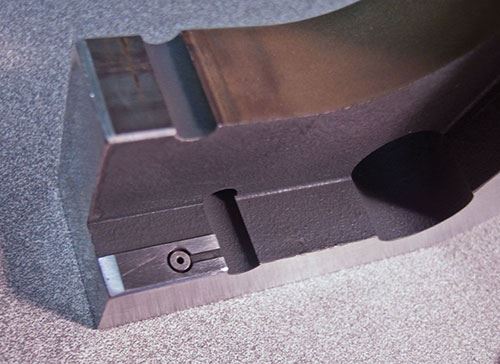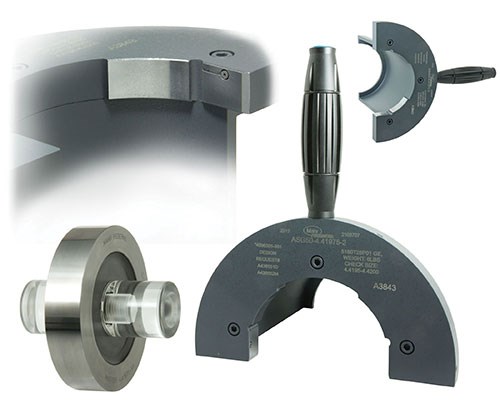Use My Shoulder for Support
Building a shoulder stop into an air snap gage takes away operator influence and boosts measurement accuracy.
Share




Hwacheon Machinery America, Inc.
Featured Content
View More





One challenge that often comes across my desk is measuring a tight tolerance on an inner diameter or outer diameter that is on a very narrow land. Often this dimension needs to be measured in fairly high volume and, frequently, in the machine.
When the application indicates both a tight tolerance and a production environment, then air gaging tops the list of possible solutions. Let’s look at a larger OD on a part where an air snap gage might be the gage of choice, as it provides the accuracy needed and can be used at the point of manufacture.
However, while air gaging is probably the best solution, there are still some measuring characteristics that need to be addressed in order to provide an easy-to-use and successful application.
The first characteristic is the length or width of the land to be checked. For air gaging to work properly, the air jet—the actual measuring part of the air system—has to be completely covered to provide the back pressure necessary to sense the diameter.
A typical air jet is 0.050 inch in diameter, meaning the land has to be at least that wide. This presents two potential problems. First, the width of the land usually has some tolerance on it, meaning that there will be some width variation.
Second, positioning the jet exactly on the land so that the jet is covered also can be a problem. Since we want the gage to be fast and easy to use, we cannot afford to have the operator spend time trying to position the air gage to within a few tenths to cover the jet. Thus, one of the rules we like to use when measuring a land is to have a width of at least 0.1 inch to ensure that the jet is covered and that it is relatively easy to position the air gage.
Even having this minimum land width can present a problem, however. An air snap or even an air plug gage is made very close to part diameter and thus uses the part to align the tool to the bore or to the ID. So when the bore is very short, there is not much surface available to do the aligning. This means the operator has to get involved again to align the tool to the bore. This introduces operator influence and degrades the performance of the gage.
This is where a good, strong shoulder stop comes in handy.
A good shoulder stop does two things for this application. When designed properly, the shoulder stop will position the jet to the center of the land. So even if the width varies slightly, the jet will be totally covered, enabling a reading. The second benefit is that the shoulder stop squares up the gage, making up for the lack of land, and takes away the operator influence.
There are a couple of ways to build a shoulder stop into an air snap gage. The most obvious is to machine it right into the snap. This works best when the land being measured is close to the end or to another smaller diameter to rest against.
On some parts, however, there may not be a good diameter to rest against for some distance. In cases like this, a tubular extension can be added to the air snap and used as the stop to square up and position the air jet on the land to be measured.
There are also other ways to address this challenge. For example, an air ring can be designed as a shoulder style where the air jet is brought close to the face of the air ring. Thus, the face is held against a reference surface of the part, which again squares up the diameter being measured and positions the jet to the correct location.
For ID gaging, it’s a bit simpler. Usually a stop collar can be incorporated to both position the jet and square up the plug on a short land inside the bore—an easy and simple addition but one that saves the operator from having to search for the land being measured.
Read Next
Setting Up the Building Blocks for a Digital Factory
Woodward Inc. spent over a year developing an API to connect machines to its digital factory. Caron Engineering’s MiConnect has cut most of this process while also granting the shop greater access to machine information.
Read MoreRegistration Now Open for the Precision Machining Technology Show (PMTS) 2025
The precision machining industry’s premier event returns to Cleveland, OH, April 1-3.
Read More5 Rules of Thumb for Buying CNC Machine Tools
Use these tips to carefully plan your machine tool purchases and to avoid regretting your decision later.
Read More














.png;maxWidth=150)




























